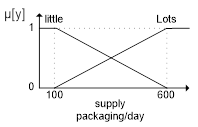Fuzzy (Tsukamoto Method)
Example of the Tsukamoto Method
Statement
- A canned food company will produce ABC food. From the last 1 month's data, the biggest demand is up to 5000 packs/day, and the smallest demand is up to 1000 packs/day. Inventory of goods in the warehouse is up to 600 packs/day at most, and at least up to 100 packs/day. With all the limitations, until now, the company has only been able to produce a maximum of 7,000 packs of goods/day, and for the sake of machine and human resource efficiency, it is hoped that the company will produce at least 2,000 packs per day.
Rule
If the company's production process uses 4 rules as follows:
1. Rule 1
IF demand DOWN and supply LOTS THEN production of goods LESS
2. Rule 2
IF demand goes DOWN and supply is LITTLE THEN production of goods is LESS
3. Rule 3
IF demand goes UP and supply is MUCH THEN production of goods INCREASES
4. Rule 4
IF demand UP and supply SLOW THEN production of goods INCREASES
Question
- How many packages of food type ABC should be produced, if the number of requests is 3,500 packages, and the inventory in the warehouse is still 300 packages? (Use the LINEAR membership function)
Answer
- There are 3 variables used: DEMAND, SUPPLY, and PRODUCTION
1. DEMAND: 1000 – 5000, x = 3500
2. INVENTORY: 100 - 600, y = 300
3. PRODUCTION: 2000 – 7000, z = ?
- DEMAND, consists of 2 fuzzy sets: DOWN and UP
µ requestDOWN[3500] = (5000 – 3500) / 4000 = 0,375
µ requestUP [3500] = (3500 – 1000) / 4000 = 0,625
- INVENTORY, consists of 2 fuzzy sets: LITTLE and LOTS
Value α- predicate and Z of each rule
Rule 1
α-predicate1 = µrequestDOWN ᴖ µsuppliesaLOST
= min (µrequestDOWN[3500] ᴖ µsuppliesaLOST[300])
= min (0,375 ; 0,4)
= 0,375
From the set of goods production LESS
Z1 = (7000 – Z) / 5000 = 0,375
= 5125
Rule 2
α-predicate2 = µrequestDOWN ᴖ µsuppliesaLITTLE
= min (µrequestDOWN[3500] ᴖ µsuppliesaLITTLE [300])
= min (0,375 ; 0,6)
= 0,375
From the set of goods production LESS
Z2 = (7000 – Z) / 5000 = 0,375
= 5125
Rule 3
α-predicate3 = µrequestUP ᴖ µsuppliesaLOST
= min (µrequestUP [3500] ᴖ µsuppliesaLOST [300])
= min (0,625 ; 0,4)
= 0,4
From the set of ADDED goods production
Z3 = (Z – 2000) / 5000 = 0,4
= 4000
Rule 4
α-predicate4 = µrequestUP ᴖ µsuppliesaLITTLE
= min (µrequestUP [3500] ᴖ µsuppliesaLITTLE [300])
= min (0,625 ; 0,6)
= 0,6
From the set of ADDED goods production
Z4 = (Z – 2000) / 5000 = 0,6
= 5000
- Calculating final Z by averaging all weighted Z's:











Tidak ada komentar:
Posting Komentar